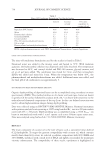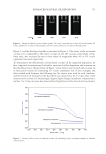681 THE MATRIX REVISITED Yet, as before, wet and dry represent extremes, and previous DSC/DTA, experiments on wool (24) and hair (25) showed that the denaturing temperature decreases with progressively increasing water content as obtained by varying the relative humidity (see Figure 7). These experimental data appear to be well fit by the Williams–Landel–Ferry (WLF) model (26), given by the equation ln(a T Reference Reference ) ( ) C T T C T T = - + - 1 2 (8) where a T reflects primarily the temperature dependence of a segmental friction coefficient or mobility on which the rates of all configurational rearrangements depend, C 1 and C 2 are empirical constants, and T Reference is 50°C. This fit allows for the conclusion that the matrix is a viscous material (27), corresponding to the viscous component of the viscoelastic description of the mechanical behavior of hair given by Equation 1. STRUCTURE AND MORPHOLOGY OF THE MATRIX Historically, the matrix has generally been viewed as an amorphous, cross-linked polymer, but the fine details of its structure were less investigated. The relatively recent progress in the analysis of KAP structures (10) has rekindled interest in studying the matrix morphology. Some of the early proposals for the fine structure of the matrix were based on an analysis of tensile measurements on wool. Crewther suggested that a layer of matrix molecules protects the helical structure of the microfibrils (28). In a second work on the same topic, Figure 7. Evolution of the peak temperature of keratin fibers with increasing water content, as reported by Haly and Snaith for DTA measurements on wool (24) and by Cao and Leroy for DSC measurements on hair (25). The experimental points fit the WLF model (26), as shown by the dotted curve (27).
682 JOURNAL OF COSMETIC SCIENCE Crewther stated that there is an “essentially uniform interaction between the microfibrils and the high-sulfur proteins of the matrix” (29). Chapman came to a similar conclusion regarding disulfide links between a less-ordered matrix and the KIFs (30). These works suggest that there is an interface between the matrix and the KIFs. In other words, it appears that the two-phase model (see Figure 1) needs to be upgraded to include three phases. Solid-state nuclear magnetic resonance (NMR) experiments involving hair, as well as DSC studies on hair at different pH values, also suggest that a three-phase model for hair (shown in Figure 8) could better explain the properties of hair (31,32). Assuming the existence of an interface between the matrix and the KIFs also necessitates adjustments to the meanings of peak temperature and enthalpy, particularly for the values recorded from the wet DSC of hair, from those given in Figure 5 to a more complex picture, suggested in Figure 8 (22,33). Crewther also suggested that the protein globules (KAPs) of the matrix, which contain a large number of internal disulfide cross-links, covalently linked to each other to form a “loose, randomly arranged or only partly oriented, network of beaded chains” (29). This model of a beaded matrix is further supported by solid-state NMR data (34), and as depicted in Figure 9, it explains well the effects of the bleaching process (18,34). Recent experiments measuring the transport of heat through hair fibers by a transient electrothermal (TET) technique (35) also suggested a grainy nanoscale matrix structure, Figure 8. Three-phase model and DSC measurements that reflect the states of the model’s three components (22,31–33).
Purchased for the exclusive use of nofirst nolast (unknown) From: SCC Media Library & Resource Center (library.scconline.org)






































































































































